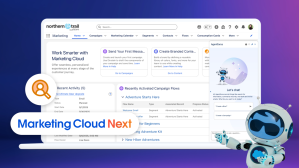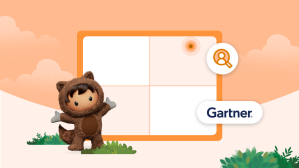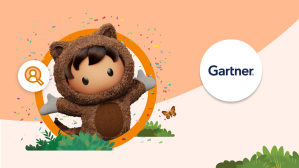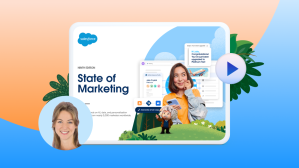In a world of TikToks and Snapchats, email rarely makes headlines. But email, one could argue, is the parent of every social media platform — and like most parents, it doesn’t get enough credit for all the work it does.
For years we’ve heard the “email is dead” refrain again and again. “Compared to many other communication channels, email hasn’t changed a lot in the last five years,” says Joe Teplow, co-founder of Rebel, now a Salesforce Company.
Yet email continues to be the heavyweight for marketing return on investment. Research from earlier this year shows email has a staggering $42 average earned for every $1 spent. Salesforce research among marketing leaders puts email in the top-three channels for ROI when it comes to acquiring, retaining, and upselling customers.
What’s more, email still gets a winning vote from consumers themselves. Sixty-four percent of consumers rank email as their preferred channel for communicating with companies.
If email has such a strong pulse, the question becomes — why do some keep trying to dig it an early grave?
If email has such a strong pulse, the question becomes — why do some keep trying to dig it an early grave?
The “last static frontier”
“Email has its limitations,” says Teplow. Founded in 2014 and acquired by Salesforce in 2018, Rebel started with a mustard-seed of an idea, which was this: If you can remove friction from the email experience, customers will be more likely to take an action.
Generally, removing customer friction has proven to be a worthy pursuit — take Amazon’s Alexa (cutting the extra steps of grabbing your device and typing) or Instacart’s grocery delivery (cutting driving to the store and pushing a cart). But the concept of removing friction in emails wasn’t something that’d been widely applied yet.
“There’s something so stable about email that allows it to be this ubiquitous channel for reaching customers,” says Teplow. “But email is one of the last static things on your phone. Think about it — it’s the last frontier of static content.”
But two forces are hitting refresh on email — interactivity and artificial intelligence — which are part of the new Salesforce innovations announced today.
Two forces are hitting refresh on email — interactivity and artificial intelligence — which are part of the new Salesforce innovations announced today.
How interactive email brings web functionality to the inbox
From a consumer point of view, inboxes have evolved in slow motion relative to other digital communication modes and the internet at large. There are things consumers do on the web without a second thought that have been a struggle for marketers to recreate in the inbox — like running a survey, for example.
“In recent years, most of the innovations in email marketing were around personalization — personalizing subject lines, personalizing content — which is all incredibly important. But there was very little change to the actual front-end of the email,” says Teplow. “No one was proposing changes to what you actually do in an email.”
But interactive email is starting to change this, mainly by making more actions possible with fewer clicks.
“It’s no longer about directing all traffic to your website if customers can take action in an email,” says Teplow. “Customers can leave a review, take a survey, or add an item to their cart without leaving the inbox. It’s empowering customers to take action where they are instead of rerouting them to a company-dictated destination.”
It’s no longer about directing all traffic to your website if customers can take action in an email.
Why Salesforce is leaning into AI-driven email
We introduced Salesforce Einstein, artificial intelligence embedded into the Salesforce Platform, in 2016. Since then, we’ve been continually seeking new AI applications to make everyone smarter and every customer interaction smoother. For email, this means an AI-powered system automatically recommending words and visual assets to use throughout every section of an email, based on individual customers’ preferences and behaviors. Other AI features are leveraging natural language processing (NLP) to help marketers find the best phrases for such things as email subject lines.
“Such a system can analyze how often an individual customer engages with email, how often they open messages and when, and what type of content resonates better with them. And it will do that at scale,” says Armita Peymandoust, Vice President of Einstein for Marketing Cloud at Salesforce.
Based on that analysis, an AI system can create an entirely personalized set of emails with the kind of attention-grabbing content that customers are more likely to engage with. “We have features in our platform that help marketers pick the right time to send those emails to their customer base. That way, they’ll receive an email at the time they’re most likely to open,” says Peymandoust.
But it can be hard to know what makes a marketing email successful outside common metrics, like click-to-open rate. Drawing on AI’s capabilities, marketers can access insights on performance and suggestions for improvement to help them tweak parts of a campaign or email as needed to boost engagement.
“You get better insights into the way messages and images are landing with audiences, for instance,” says Peymandoust. “That means you can continuously optimize your messaging in a way that will attract customers and build a relationship with your brand. And, of course, receiving support from automated information in these ways frees marketers up to have more time to focus on strategy.”
Using AI-powered email to build customer loyalty
Orvis — the popular fly fishing, hunting, and sporting goods retailer — has been in business since 1856, but its approach to marketing is anything but old-fashioned. The company is pushing to improve customer loyalty in part by improving AI-powered email marketing.
“If we wanted to get closer to our one-to-one marketing goal, we needed to know a lot more about who our customers are and what we should be talking to them about,” says Tim Delles, Orvis Senior Manager for Email Strategy and Innovation. “We needed a more sophisticated AI solution that could help us break the mold.”
Orvis turned to Salesforce’s AI-powered content selection features to combine customer data and content to give an added boost. “We’re now sending many variations of an email in a single send. Previously, five variations in a send was difficult. As we continue to learn more about our consumers and our ability to deliver highly personalized conversations, we continue to push the bounds with personalization — right down to the content and structure of each email we send,” says Delles.
“If you start to build trust with your customers in their inbox, they’ll have trust in what you’re selling, and trust in the stories you’re telling, and know you’re not going to fill their inbox with spam,” says Delles. “There are so many other channels, but email helps to get the conversation started and focused, so it’s vital to get it right.”
Future-proofing email
“Our goal is to have Einstein as an ever-present digital assistant to email marketers,” says Peymandoust. “We’re always looking at the machine learning, image recognition, and NLP technology available to us via our extended Einstein platform and research teams, and how we can combine these to create powerful new features.”
“At the start, marketers approached email like digital mass-mailer postcards,” Teplow says. But while the industry has moved beyond batch-and-blast, some still view email with a set-and-forget mindset. “New things are happening. We’re seeing more and more of this functionality being supported by email clients, where they’re jumping on the bandwagon and proposing their own ideas for future uses. Those who aren’t forward-thinking about email can get left behind.”
For more information, see the announcement Salesforce Reinvents Email Marketing with New Einstein, Interactive and Productivity Innovations.























